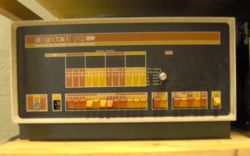Difference between revisions of "PDP-8/E"
From Computer History Wiki
(Improve a bit, mention /F and /M) |
|||
| Line 7: | Line 7: | ||
}} | }} | ||
| − | Introduced in 1970, the PDP-8/E was an improved model and | + | Introduced in 1970, the '''PDP-8/E''' was an improved model in the [[PDP-8]] line, and introduced the [[OMNIBUS]] for interfacing to [[device controller]]s. |
| + | |||
| + | The '''PDP-8/F''' was a cost-reduced version of the -8/E with the same [[Central Processing Unit|CPU]] and [[main memory]], but only a single OMNIBUS [[backplane]]. The '''PDP-8/M''' is the [[Original Equipment Manufacturer|OEM]] version of the PDP-8/F. | ||
| + | |||
| + | It could perform an addition to the accumulator in 2.6 microseconds, and a 12 by 12 bit multiplication with 24 bit result in 40 microseconds with the math extension hardware. | ||
{{Nav PDP-8}} | {{Nav PDP-8}} | ||
Revision as of 16:18, 2 September 2018
| PDP-8/E | |
 PDP-8/E front panel | |
| Year Introduced: | 1970 |
|---|---|
| Memory Size: | Maximum of 32 kwords in eight 4 kword banks |
Introduced in 1970, the PDP-8/E was an improved model in the PDP-8 line, and introduced the OMNIBUS for interfacing to device controllers.
The PDP-8/F was a cost-reduced version of the -8/E with the same CPU and main memory, but only a single OMNIBUS backplane. The PDP-8/M is the OEM version of the PDP-8/F.
It could perform an addition to the accumulator in 2.6 microseconds, and a 12 by 12 bit multiplication with 24 bit result in 40 microseconds with the math extension hardware.
| v • d • e PDP-8 Computers, Software and Peripherals |
|---|
| PDP-8s: PDP-5 • PDP-8 • LINC-8 • PDP-8/S • PDP-8/I • PDP-8/L • PDP-12 • PDP-8/E • PDP-8/F • PDP-8/M • PDP-8/A
Workstations: VT78 Also: PDP-8 family • PDP-8 architecture • PDP-8 Memory Extension units |